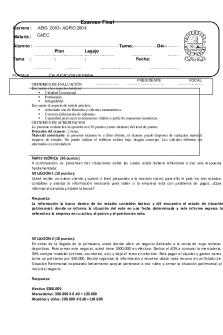BIO001L EX002 BLAS PDF

| Title | BIO001L EX002 BLAS |
|---|---|
| Course | Bachelor of Science in Psychology |
| Institution | Manila Central University |
| Pages | 3 |
| File Size | 215.9 KB |
| File Type | |
| Total Downloads | 79 |
| Total Views | 149 |
Summary
ANAPHY LAB EXERCISE...
Description
REVIEW SHEET EXERCISE 2 Name BLAS, SHAIRRA MAE B. _ Lab Time/Date 02/22/21 – 8:30 – 11:30 AM Organ Systems Overview 1. Use the key below to indicate the body systems that perform the following functions for the body; note that some body -systems are used more than once. Then, circle the organ systems (in the key) that are present in all subdivisions of the ventral body cavity. Key: a. cardiovascular d. b. digestive e. endocrine f.
integumentary g. nervous lymphatic/immunity h. reproductive muscular i. respiratory
j. skeletal k. urinary
k. urinary
1. rids the body of nitrogen-containing wastes
c. endocrine
2. is affected by removal of the thyroid gland
j. skeletal
3. provides support and levers on which the muscular system acts
a. cardiovascular
4. includes the heart
h. reproductive
5. has a menstrual cycle in females
d. integumentary
6. protects underlying organs from drying out and from mechanical damage
e. lymphatic/immunity a. cardiovascular 7. protects the body; destroys bacteria and tumor cells b. digestive
8. breaks down ingested food into its building blocks
i. respiratory
9. removes carbon dioxide from the blood
a. cardiovascular
10. delivers oxygen and nutrients to the tissues
f. Muscular
11. moves the limbs; facilitates facial expression
k. urinary
12. conserves body water or eliminates excesses
c. endocrine
1
and
h.
reproductive
13. facilitate
conception
and childbearing c. endocrine
14. controls the body by means of chemical molecules called hormones
d. integumentary
15. is damaged when you cut your finger or get a severe sunburn
2. Using the above key, choose the organ system to which each of the following sets of organs or body structures belongs. e. lymphatic / immunity
1. thymus, spleen, lymphatic vessels
j. skeletal
2. bones, cartilages, tendons
c. endocrine
3. pancreas, pituitary, adrenals
i. respiratory
4. trachea, bronchi, lungs
d. integumentary
5. epidermis, dermis, and cutaneous sense organs
h. reproductive
6. testis, ductus deferens, urethra
b. digestive
7. esophagus, large intestine, rectum
f. muscular
8. muscles of the thigh, postural muscles
3. Using the key below, place the following organs in their proper body cavity. Key: a.
abdominopelvic
a. abdominopelvic d. thoracic
cranial
2. esophagus 3. large intestine
a. abdominopelvic
4. liver
a. abdominopelvic
c. spinal
1. stomach
a. abdominopelvic
c. spinal
2
b.
5. spinal cord 6. urinary bladder
d. thoracic
7. heart
d. thoracic
8. trachea
d.
thoracic
a. abdominopelvic
9. rectum
4. Using the organs listed in question 3 above, record, by number, which would be found in the abdominal regions listed below. 5, 6, & 9
1. hypogastric region
3&4
2. right lumbar region
3&5
3. umbilical region
1,2,5,7 &8
4. epigastric region
3
5. left iliac region
1 &4
6. left hypochondriac region
5. The levels of organization of a living body are chemical, organ organ system , , and organism.
cells
,
tissue
,
6. Define organ. A part of the body formed of two or more tissues that perform a specialized function. 7. Using the terms provided, correctly identify all of the body organs provided with leader lines in the drawings shown below. Then name the organ systems by entering the name of each on the answer blank below each drawing. Key: blood brain
heart kidney
vessels
nerves spinal cord sensory receptor ureter
urethra urinary bladder
Brain Sensory Receptor Spinal Cord
Kidney Heart
Nerves
Ureter Urinary Bladder Urethra
Blood Vessels
a.
Nervous System
b. Cardiovascular System
c. Urinary/ Excretory System
8. Why is it helpful to study the external and internal structures of the rat? It is used to understand the structures as it is close to humans own structure....
Similar Free PDFs

BIO001L EX002 BLAS
- 3 Pages

Acrostico Blas - Apuntes 1
- 2 Pages

2019 BLAS Degree PLAN Guide
- 10 Pages

1er Parcial Economía ubp Blas pascal
- 12 Pages
Popular Institutions
- Tinajero National High School - Annex
- Politeknik Caltex Riau
- Yokohama City University
- SGT University
- University of Al-Qadisiyah
- Divine Word College of Vigan
- Techniek College Rotterdam
- Universidade de Santiago
- Universiti Teknologi MARA Cawangan Johor Kampus Pasir Gudang
- Poltekkes Kemenkes Yogyakarta
- Baguio City National High School
- Colegio san marcos
- preparatoria uno
- Centro de Bachillerato Tecnológico Industrial y de Servicios No. 107
- Dalian Maritime University
- Quang Trung Secondary School
- Colegio Tecnológico en Informática
- Corporación Regional de Educación Superior
- Grupo CEDVA
- Dar Al Uloom University
- Centro de Estudios Preuniversitarios de la Universidad Nacional de Ingeniería
- 上智大学
- Aakash International School, Nuna Majara
- San Felipe Neri Catholic School
- Kang Chiao International School - New Taipei City
- Misamis Occidental National High School
- Institución Educativa Escuela Normal Juan Ladrilleros
- Kolehiyo ng Pantukan
- Batanes State College
- Instituto Continental
- Sekolah Menengah Kejuruan Kesehatan Kaltara (Tarakan)
- Colegio de La Inmaculada Concepcion - Cebu











